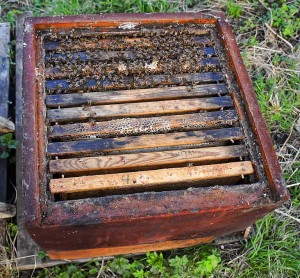Two weeks after the first check after winter ( a week ago) I visited Karin again and checked the colony. See the first post on this subject for a background. But this colony has been on its own on two boxes since autumn 2007. No Varroa treatment for example. The entrance is on the top end of the photo. The cluster is sitting closest to the entrance but in the top box.
Two weeks ago There was brood on the first three combs. The bees covered almost four combs. On the fourth comb it was a small circle of brood at the bottom on the side to the entrance. This day it was capped brood also on the fourth comb to the upper right. The fifth comb, full of food, which had been under the feeding hole, was moved two frame back to become no 7. The two rear combs, one good drawn 4.9 cell size, and one good draw 5.1 mm cell size were moved to become no five and six. They had only little food. The rest (two – not so good drawn 4.9, the replacement combs after harvesting two frames autumn 2012, the first management since autumn 2007) were moved to the back. They were half full of food.
The rear two combs and the bottom box will be replaced in another two weeks after this visit.. No sign of any mites or viruses or any other diseases. One thing was noticed. The capped brood had a shot gun pattern. It is not due to a failing queen – the colony is expanding well. As no sign of mites or viruses were seen it’s unlikely but still possible the mite population is so big the colony is heavily cleaning out mite infested brood. A more probable explanation may be that the queen has mated with quite some drones from this same colony. The colony is quite alone in the neighbourhood. But on the other hand the entrance whole was very small between the bottom queen excluder and the soft polyurethane plastic box. The bottom excluder was a surprise and of course removed two weeks earlier. It made the survival of the colony still more surprising – or was it contributing to it?
